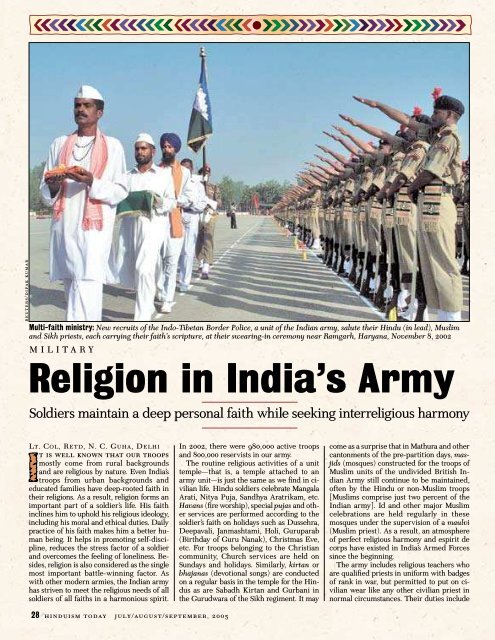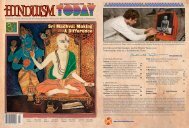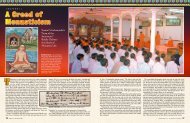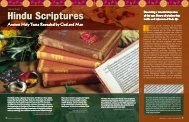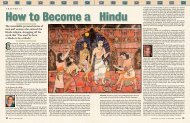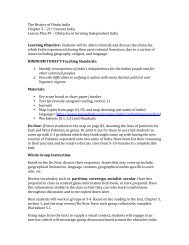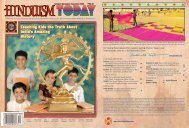Hinduism Today July/August/September 2005
Hinduism Today July/August/September 2005
Hinduism Today July/August/September 2005
You also want an ePaper? Increase the reach of your titles
YUMPU automatically turns print PDFs into web optimized ePapers that Google loves.
euters/dipak kumar<br />
Multi-faith ministry: New recruits of the Indo-Tibetan Border Police, a unit of the Indian army, salute their Hindu (in lead), Muslim<br />
and Sikh priests, each carrying their faith’s scripture, at their swearing-in ceremony near Ramgarh, Haryana, November 8, 2002<br />
m i l i t a r y<br />
Religion in India’s Army<br />
Soldiers maintain a deep personal faith while seeking interreligious harmony<br />
Lt. Col, Retd, N. C. Guha, Delhi<br />
t is well known that our troops<br />
mostly come from rural backgrounds<br />
and are religious by nature. Even India’s<br />
troops from urban backgrounds and<br />
educated families have deep-rooted faith in<br />
their religions. As a result, religion forms an<br />
important part of a soldier’s life. His faith<br />
inclines him to uphold his religious ideology,<br />
including his moral and ethical duties. Daily<br />
practice of his faith makes him a better human<br />
being. It helps in promoting self-discipline,<br />
reduces the stress factor of a soldier<br />
and overcomes the feeling of loneliness. Besides,<br />
religion is also considered as the single<br />
most important battle-winning factor. As<br />
with other modern armies, the Indian army<br />
has striven to meet the religious needs of all<br />
soldiers of all faiths in a harmonious spirit.<br />
In 2002, there were 980,000 active troops<br />
and 800,000 reservists in our army.<br />
The routine religious activities of a unit<br />
temple—that is, a temple attached to an<br />
army unit—is just the same as we find in civilian<br />
life. Hindu soldiers celebrate Mangala<br />
Arati, Nitya Puja, Sandhya Aratrikam, etc.<br />
Havans (fire worship), special pujas and other<br />
services are performed according to the<br />
soldier’s faith on holidays such as Dussehra,<br />
Deepavali, Janmashtami, Holi, Guruparab<br />
(Birthday of Guru Nanak), Christmas Eve,<br />
etc. For troops belonging to the Christian<br />
community, Church services are held on<br />
Sundays and holidays. Similarly, kirtan or<br />
bhajanas (devotional songs) are conducted<br />
on a regular basis in the temple for the Hindus<br />
as are Sabadh Kirtan and Gurbani in<br />
the Gurudwara of the Sikh regiment. It may<br />
come as a surprise that in Mathura and other<br />
cantonments of the pre-partition days, masjids<br />
(mosques) constructed for the troops of<br />
Muslim units of the undivided British Indian<br />
Army still continue to be maintained,<br />
often by the Hindu or non-Muslim troops<br />
[Muslims comprise just two percent of the<br />
Indian army]. Id and other major Muslim<br />
celebrations are held regularly in these<br />
mosques under the supervision of a maulvi<br />
(Muslim priest). As a result, an atmosphere<br />
of perfect religious harmony and espirit de<br />
corps have existed in India’s Armed Forces<br />
since the beginning.<br />
The army includes religious teachers who<br />
are qualified priests in uniform with badges<br />
of rank in war, but permitted to put on civilian<br />
wear like any other civilian priest in<br />
normal circumstances. Their duties include<br />
Shell temple: Members of the Indian Army pray at a makeshift temple made of spent shell casings at Kargil, <strong>August</strong> 26, 1999<br />
religious discourses and lectures on values<br />
to the troops. Traditionally, these religious<br />
teachers come from brahmin families or<br />
priestly castes. They are adept in ritualistic<br />
worship. It is customary in most army<br />
units for a religious teacher to read out the<br />
horoscope of the unit on the Raising Day<br />
of the unit (anniversary of the unit’s founding),<br />
to which the troops listen with rapt<br />
attention as it gives them an indication of<br />
the unit’s likely performance during the rest<br />
of the year. Tying of the sacred thread on<br />
the wrists and applying vermilion tilak on<br />
the forehead of the soldiers by the religious<br />
teacher gives them a sense of purity and<br />
happiness. It also inculcates a sense of belonging<br />
to the unit.<br />
Attendance or roll call is taken of the soldiers<br />
for the Mandir (temple) parade every<br />
Sunday and at important religious functions.<br />
This is how spiritual discipline is instilled in<br />
the soldiers. In a noncombat location, even<br />
the women and the children of our soldiers<br />
attend these functions. As the children of<br />
the soldiers grow up in such a close-knit<br />
family environment, many of them later join<br />
the Armed Forces. Even in the remote and<br />
high altitude mountainous terrain in the operational<br />
combat areas, a religious teacher<br />
visits the troops regularly, which enhances<br />
the morale of the troops greatly. In any case,<br />
a religious institution is also the place where<br />
exhausted, broken and desperate souls take<br />
refuge to recover their lost strength. Post-<br />
Korean War psychological research has<br />
shown that strong religious faith builds up<br />
mental resistance to brainwashing. Therefore,<br />
a religious institution such as a temple,<br />
gurudwara or church is authorised to every<br />
unit of our Armed Forces and preserved<br />
and maintained as such.<br />
In this connection, the inspiring words of<br />
Swami Vivekananda uttered a century ago<br />
are most appropriate and still hold good:<br />
“Your forefathers underwent everything<br />
boldly, even death itself, but preserved their<br />
religion. Temple after temple was broken<br />
down by the foreign conquerors, but no<br />
sooner had the wave passed than the spire<br />
of the temple rose up again. Some of these<br />
old temples of Southern India and those like<br />
Somnath of Gujarat will teach you volumes<br />
of wisdom, will give you a keener insight<br />
into the history of the race than any amount<br />
of books. Mark how these temples bear the<br />
marks of a hundred attacks and a hundred<br />
regenerations, continually destroyed and<br />
continually springing up out of the ruins,<br />
rejuvenated and strong as ever! That is the<br />
national mind, that is the national life-current.<br />
Follow it, and it leads to glory.”<br />
Hindu Observances: Some of the older and<br />
most famed Army regiments remain caste,<br />
religion or region based, with the religious<br />
observances of the regiment following its tradition.<br />
For example, the icon of Lord Vishnu,<br />
popularly known as Badri Vishal, installed<br />
at Badrinath in Garhwal, Uttar Pradesh, by<br />
Adi Shankaracharya, is the presiding deity<br />
of the Garhwal Rifles, an Infantry regiment<br />
of the Indian Army drawn from this area.<br />
Badri Vishal is worshipped in all the Battalions<br />
of the Garhwal Rifles. For the Garhwal<br />
Rifles personnel, Badrinath is of supreme<br />
significance. The name of Lord Badri even<br />
embellishes the Garhwal Rifles’ war cry and<br />
is their ultimate motivating force.<br />
The typical person from Garhwal is animated<br />
with intense religious fervor. As per<br />
Markandeya Purana, Goddess Durga is the<br />
powerful Deity who killed the demon king<br />
Mahishasura in a fierce battle and restored<br />
peace and tranquillity in heaven. The Goddess<br />
Durga is represented as a golden-colored<br />
Deity with ten hands having a gentle<br />
countenance, but according to other accounts<br />
the Goddess is having eight hands.<br />
Being the embodiment of shakti (strength),<br />
troops get a lot of happiness and derive inner<br />
strength by worshipping Her image. In<br />
all the battalions of the Garhwal Rifles, Goddess<br />
Durga with eight hands is worshipped.<br />
Within the Garhwal Rifles, Vijay Dashami<br />
afp/surinder oberoi<br />
28 hinduism today july/august/september, <strong>2005</strong> j u ly / au g u s t / s e p t e m b e r , 2 0 0 5 h i n d u i s m t o d ay 29


